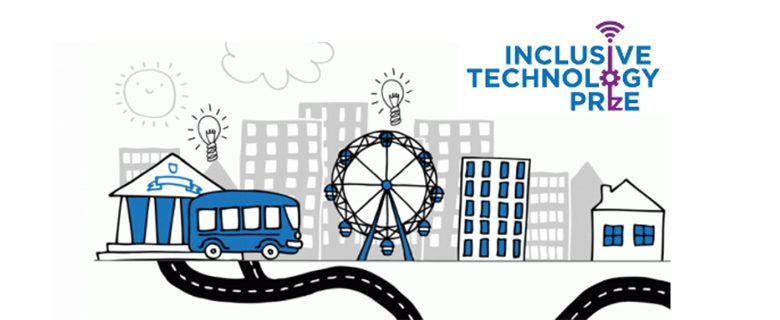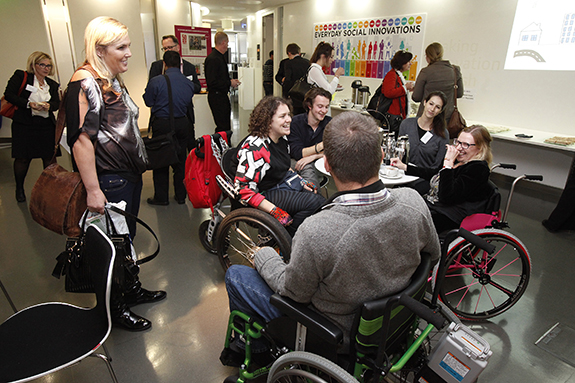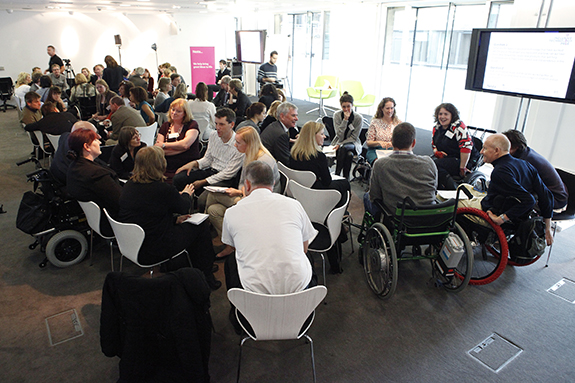
Inclusive Technology Prize – apply now!
Nesta is looking for innovation in products, technologies and systems that enable disabled people, their families, friends and carers equal access to life’s opportunities. Innovations can relate to any aspect of life including, but not limited to, education, home, leisure, transport and work. Find out how to apply and read about Gordon Richardson’s experience below!
 I recently took part in a focus group for innovation charity Nesta and their Inclusive Technology Prize, a competition aimed at disabled people, their families and carers, designers, makers and entrepreneurs, all of whom are being challenged to develop the next generation of products, services and technologies that will make a real difference to the 1 in 5 of us living with limiting long term illness or disability in the UK.
I recently took part in a focus group for innovation charity Nesta and their Inclusive Technology Prize, a competition aimed at disabled people, their families and carers, designers, makers and entrepreneurs, all of whom are being challenged to develop the next generation of products, services and technologies that will make a real difference to the 1 in 5 of us living with limiting long term illness or disability in the UK.
We were coming up with ideas about what could help make the UK more inclusive such as improved wheelchairs, transport, home aids and more. The fact that we live in a time of such technological capability makes challenges like this all the more exciting. New technology is vital to improving the lives of people with disabilities, and these advances are often of benefit of the general population as well.
Developments like satnav help the general public every day, but have also enabled trail products that have the ability to guide blind people through a city. Even innovations now considered commonplace like automatic shop doors make things easier for everyone, yet also mean that someone in a wheelchair can enter a shop in exactly the same way as anyone else.
This inclusivity is integral to a wider social understanding of disability and each new development is a step forward to greater equality. I see the stigma of disability progressing in the same way as the women’s rights movement or racial equality, with the aim to make school, employment, and society as a whole more inclusive and accessible for all.
 With regard to social inclusion, the first stage of this for most children is schooling. In education, things are improving, but there is still work to be done. More schools now accept disabled students and teach them in the same environment as all pupils. This can mean certain adaptations must be made within schools but ultimately, its important that all students at all levels of qualification can have access to the best education they can get, without having to compromise on quality or travel to special schools.
With regard to social inclusion, the first stage of this for most children is schooling. In education, things are improving, but there is still work to be done. More schools now accept disabled students and teach them in the same environment as all pupils. This can mean certain adaptations must be made within schools but ultimately, its important that all students at all levels of qualification can have access to the best education they can get, without having to compromise on quality or travel to special schools.
In the next key hurdle, there is even more to be done. Employment has consistently been an area of disparate opportunities for those with and without disabilities. With plenty of potentially available jobs on the market, it’s a matter of encouraging employers to take time to consider the many positive qualities that applicants have to offer. The fact that one may need extra support either with equipment or technology does not disqualify them from being able to do certain jobs on a par with anyone else. Things like voice recognition on computers combined with equal opportunity practice are slowly making opportunities more available on a wider scale to those with disabilities, but this is a matter of taking into account jobs across varying levels of qualification and sector. New building and planning specifications have certainly progressed but the spread of adaptations like stair lifts to the workplace could also have a positive effect.
Having a job is a key aspect of life often overlooked for disabled people. Those on disability benefit, especially those with more severe disabilities, struggle to keep up with the inevitable costs of equipment and support, many of which are not covered by the NHS. My wheelchair is semi-powered, meaning it is half electric and half powered by me. This means I can maintain control and maneuverability of a smaller and less heavy chair than a fully electric model, but can also go into the local village on my own without having to drive. However, it came at a hefty price. I’m lucky enough to be able to support myself financially but many in the UK are not in such a position.
 Ramps, wheelchairs, hearing aids and home adaptations all come at a cost. As with all new innovations, products will develop over time and costs will inevitably come down. However, a job is a starting point and one that not only enables an income, equipment and quality of life, but also a sense of inclusion and equality in society in general.
Ramps, wheelchairs, hearing aids and home adaptations all come at a cost. As with all new innovations, products will develop over time and costs will inevitably come down. However, a job is a starting point and one that not only enables an income, equipment and quality of life, but also a sense of inclusion and equality in society in general.
For more information on the Inclusive Technology Prize please visit www.
By Gordon Richardson
Gordon Richardson has been a wheelchair user since the age of 3, when he was diagnosed with Polio. After attending university, he pursued a career as a chartered accountant until he retired aged 50. Gordon has spent the last 12 years working and volunteering for disability charities and schools in Bristol. He is Chairman of Action on Work and Disability UK, a charity working to help to get disabled people into work and advising the government and amongst others London Transport Authorities on transportation for people with disabilities. He is also on the executive committee of Designabilty (previously the Bath Institute of Medical Engineering).
Check out…
• Calling all budding disabled film makers!
• UltraBikes keep blind cyclists on track
• Go ON Gold: improving accessibility to the internet
Do you have an invention you want to shout about? Get in touch by messaging us on Facebook, tweeting us @DHorizons, emailing us at editor@disabilityhorizons.com or leaving your comments below.